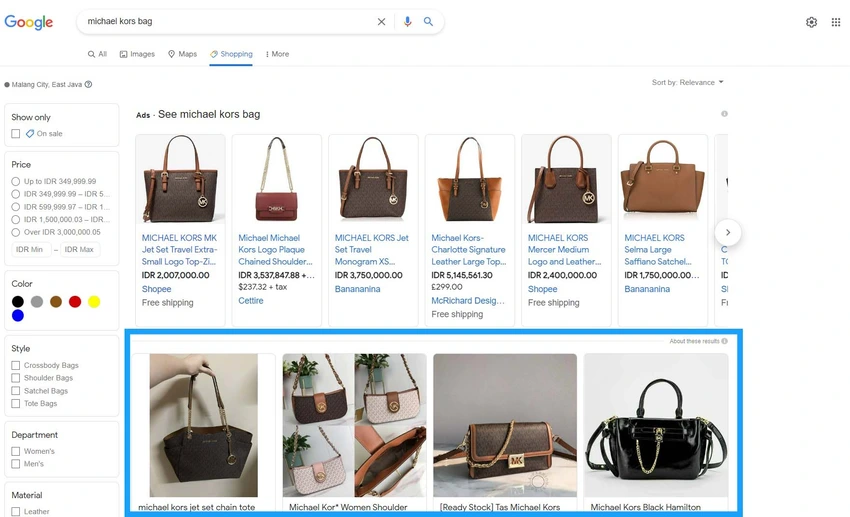We use cookies
This site uses cookies from cmlabs to deliver and enhance the quality of its services and to analyze traffic..
We use cookies
This site uses cookies from cmlabs to deliver and enhance the quality of its services and to analyze traffic..
Last updated: Aug 09, 2024

Disclaimer: Our team is constantly compiling and adding new terms that are known throughout the SEO community and Google terminology. You may be sent through SEO Terms in cmlabs.co from third parties or links. Such external links are not investigated, or checked for accuracy and reliability by us. We do not assume responsibility for the accuracy or reliability of any information offered by third-party websites.
The trend of buying products through e-commerce is increasing every year. This makes business owners compete in a tighter digital market. Just as SEO helps websites to grow, so does e-commerce SEO provide a strategy for retailers to rank high in the SERPs.
In this article, we will provide a basic understanding of e-commerce SEO optimization as well as its best practices to improve ranking in search results.
SEO e-commerce is a strategy to ensure that an e-commerce website page achieve high rankings and can increase visibility on search engine result pages (SERP).
For e-commerce websites, ranking and visibility are very important since they make your website easier to find and more likely to generate conversions.
SEO can not only be applied to article types of content, but also other types including e-commerce pages. Long term implementation of e-commerce SEO can help businesses to be more effective in increasing their conversions and managing their spendings proportionally.
If you only use paid searches to increase conversions, then the amount of costs you incur will be very large in the long term. Not to mention the ad blockers and ad blindness can reduce the effectiveness of the ads you run.
You can not merely rely on paid searches in this case. It is better to start implementing e-commerce SEO practices for sustainable business growth.

To be able to implement e-commerce SEO, there are three main things that you must apply. The four best practices for implementing SEO for e-commerce are keyword research, e-commerce website architecture, on-page SEO, and content marketing. Here's the full explanation:
The first thing you need to do to improve your e-commerce SEO is keyword research. Not only article pages that need target keywords, e-commerce pages need them as well. You can put keywords in the meta title, meta description, product headline, subheadline, product description, and image alternate attributes (alt image).
Keyword research for article and e-commerce pages utilizes the same method. However, the types of keywords used are different. E-commerce pages are intended for conversions so the keywords you use should be for transactional types.
This type of keyword usually contains action words such as 'buy' and 'sell'. It can also be a word that contains an element of purchasing such as 'price', 'promo', and 'discount'. You can find a selection of keywords and their search volume through various tools such as Google Keyword Planner.
Website architecture refers to how the pages on a website are organized. It is an important aspect to improve user experience and increase crawlability of search engine robots.
In order to improve e-commerce SEO performance, you have to make sure that your website already has a good architecture.
Create a Simple and Easy to Navigate Website Architecture
Ideally, every page on a website should be accessible with three clicks from the main page. If your audience needs five or even ten clicks to find the product page they're looking for, it means that your website architecture is difficult to navigate.
Use Free Listing from Google

Google provides a Free Listing feature to display your products on various Google platforms such as Shopping Tab, Youtube, Google Search, Google, Image, and Google Lens. You can use this feature for free.
The first step to getting Free Listing from Google is to register with the Merchant Center and link it to your website. Here are the steps:
After that, you can activate the Free Listing feature by following the steps below:
The next method to implement e-commerce SEO is to optimize on-page SEO. In on-page SEO, the parts you optimize include meta tags, internal links, keywords, headings, and schema markup.
Maximize the Use of Keywords in Strategic Positions
After finding what keywords you will use, then you should be able to find out where you can put those keywords. The selection of keyword positions greatly affects the process of search engine robots in identifying the target keywords of the pages.
You can put the keywords in the meta title and meta description, product page titles, heading tags, initial paragraphs in product descriptions, and slugs in product pages. Keep in mind to avoid keyword stuffing because your content will be considered worthless by search engine robots.
Write Attractive Title Tags and Meta Descriptions
Meta title and meta description will appear on the SERP when an audience searches for a keyword and finds your product page. In addition to target keywords, you also have to write interesting titles and descriptions that are able to influence audiences to click on your product page.
The way to do it is to look at the meta tags owned by your competitors and rewrite them in a different way. Make sure to keep the tags or description from being truncated on the display in the SERP. The maximum length of the meta title is 70 characters and the maximum length of the meta description is 160 characters.
To help you create the proper title tag and meta description, you can use the Page Title and Meta-Desc Checker tools from cmlabs.
Create an SEO-Friendly Product Description
In the product page, you must describe your product completely in an SEO-friendly way. Provide all the information that is needed and potentially asked by potential buyers.
You can insert target keywords in the description section. Make sure to also separate each information by using headings so that product descriptions can be more organized.
Use LSI Keywords
LSI or Latent Semantic Index Keyword is a type of keyword that is related to or resembles the main target keyword. Using it can strengthen the context of your content. This type of keyword can also help product pages to get more traffic through a wide selection of related keywords.
Add Internal Links
A good website architecture depends on the internal links that connect one page to another. You should be able to create internal links by linking pages from general to specific, or from the awareness stage to the conversion stage.
Add Product Markup Schema
Schema markup is a special code to help search engine robots identify the content of web pages properly. You can use the markup schema on your product pages. Some types of schema markup for product pages that are commonly used are reviews and ratings.
Later, when you have installed a review type markup schema, your website page will have a number of reviews and a rating value on the SERP. Having schema markup can be an added value that attracts audiences to visit your page.
Use the JSON-LD Schema Generator tool from cmlabs to help you create codes for your site’s schema markup.

Content is a magnet that can bring in a lot of traffic to your website. Although the main focus of an e-commerce website is to sell products, that doesn't mean your website should not be deprived of content. Providing informative content will make users more interested to visit your website.
Define Content Marketing Targets and Channels
The first thing you should know before creating content is your target audience and marketing channels. The target audience must match with your business niche. In this case, creating a buyer persona can help you determine your target audience.
The next thing to do is to find out where your audiences usually gather online. Take a look at online forums like Quora. In doing so, you will know what is discussed in the forum and what terms they usually use. This can help you to find ideas to create content.
If you are having trouble producing content on your e-commerce website, Content Marketing Services from cmlabs can be the right solution for you.
Collect Most Searched Keywords
To create content on e-commerce websites, you can use informational keywords. This type of keyword is sought after by the audience. Hence, it has a high search volume. Even so, the audience who looks for this type of keyword has a small tendency to make a purchase.
Create Quality Content
Create quality content based on the results of keyword research that you have done before. Quality content can answer the needs of the audience and help them solve their problems.
By creating quality content, your audience will read it and make them click on the CTA. Then, you can redirect to the e-commerce product page so that your audience can convert.
Thus, an explanation of the meaning of e-commerce SEO, the benefits of implementing it, and best practices that you can apply, such as keyword research, website architecture, on-page SEO, and content marketing.
If you are interested in implementing e-commerce SEO, cmlabs provides SEO consulting services that can help your website to get a good performance on the SERPs.
WDYT, you like my article?